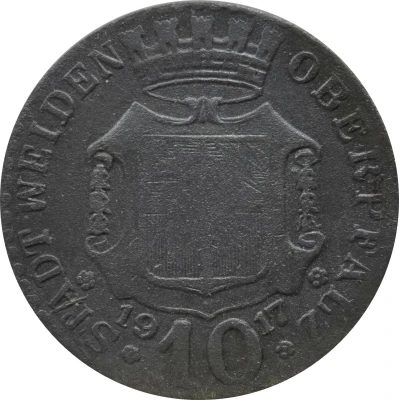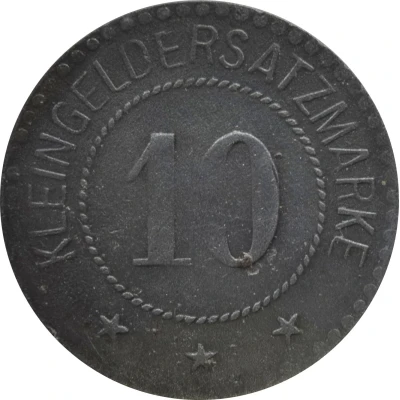


© Willem63 (CC BY-NC-SA)
10 Pfennigs - Weiden
1917 year| Zinc | 1.5 g | 20.1 mm |
| Issuer | City of Weiden in der Oberpfalz (Federal state of Bavaria) |
|---|---|
| Emperor | William II (Wilhelm II) (1888-1918) |
| Type | Standard circulation coin |
| Year | 1917 |
| Value | 10 Pfennigs (10 Pfennige) (0.10) |
| Currency | Mark (1914-1924) |
| Composition | Zinc |
| Weight | 1.5 g |
| Diameter | 20.1 mm |
| Thickness | 1.0 mm |
| Shape | Round |
| Technique | Milled |
| Orientation | Medal alignment ↑↑ |
| Demonetized | Yes |
| Updated | 2024-10-04 |
| Numista | N#16404 |
|---|---|
| Rarity index | 77% |
Reverse
Pearl rim, legend surrounding rope circle with denomination centered
Script: Latin
Lettering:
KLEINGELDERSATZMARKE
10
★ ★ ★
Edge
Plain
Comment
Issuing body: [Stadt, Bayern].Interesting fact
The 10 Pfennigs - Weiden 1917 coin from the City of Weiden in der Oberpfalz (Federal state of Bavaria) is interesting because it was made of zinc, which was a unusual material for coins at that time. Most coins were made of metals like silver, gold, or copper, but the use of zinc in this coin reflects the economic and political circumstances of Germany during World War I, when there was a shortage of traditional coinage metals. This coin is a unique example of how countries have adapted their currency to meet the needs of their economy and population during times of crisis.